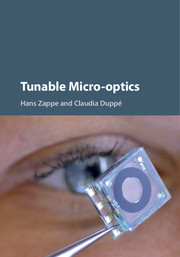Book contents
- Frontmatter
- Dedication
- Contents
- List of contributors
- List of acronyms
- Part I Introduction
- Part II Devices and materials
- Part III Systems and Applications
- 11 Characterization of Micro-optics
- 12 Photonic Crystals
- 13 MEMS Scanners for OCT Applications
- 14 Liquid Crystal Elastomer Micro-optics
- 15 Adaptive Scanning Micro-eye
- 16 Hyperspectral Eye
- 17 Plenoptic Cameras
- Index
- References
13 - MEMS Scanners for OCT Applications
from Part III - Systems and Applications
Published online by Cambridge University Press: 05 December 2015
- Frontmatter
- Dedication
- Contents
- List of contributors
- List of acronyms
- Part I Introduction
- Part II Devices and materials
- Part III Systems and Applications
- 11 Characterization of Micro-optics
- 12 Photonic Crystals
- 13 MEMS Scanners for OCT Applications
- 14 Liquid Crystal Elastomer Micro-optics
- 15 Adaptive Scanning Micro-eye
- 16 Hyperspectral Eye
- 17 Plenoptic Cameras
- Index
- References
Summary
Introduction
OCT, or optical coherence tomography, is an optical signal processing system to visualize the cross-sectional image of a semi-transparent object by spatially scanning the probe light and by reconstructing the internal structural image from the optical interference of the back-scattered light. The principle of OCT was filed as a Japanese patent in 1990 by Tanno et al. with Yamagata University, Japan (Tanno et al. 1990), and the first demonstration was independently performed in 1991 by Fujimoto et al. with MIT, Massachusetts (Huang et al. 1991).
Since the commercial release of the first OCT system in 1996 by Humphrey Instruments (Carl Zeiss Meditec Inc., USA), the non-invasive OCT inspection has been used in various fields of medical diagnosis such as dental caries visualization (Jones et al. 2006), periodontal dentistry (Colston et al. 1997), and esophagus biopsy (Su et al. 2007). The principle of OCT is also used for endoscope applications such as gastroenterology and angioscopy (Tearney et al. 1996, 1997, Bouma et al. 2000). Owing to the three-dimensional (3D) visualization capability, OCT is most beneficial in fundoscopy to diagnose symptoms such as retinal detachment and macular hole that are difficult to perform based on the limited information from the surface observation. The image resolution of the OCT system is generally as good as a few microns, which exceeds those of other instruments such as ultrasonic imaging, computerized tomography (CT) scan, or nuclear magnetic resonance (NMR) imaging. Even a small plaque fragment deposited on the inner wall of a coronary artery can be visualized by vascular endoscopy with OCT (Yabushita et al. 2002).
Optical micro-electro-mechanical systems (MEMS) technology has brought significant breakthroughs to improve the performance of OCT systems in terms of faster frame rate and higher image resolution through the new generation of wavelength tunable light source. It has also contributed a lot to produce optical fiber endoscope OCTs, where compactness is the most valuable factor for medical use. In this chapter, we discuss the principle of the OCT system, and look into the use of optical MEMS scanners for the wavelength tunable light source in OCT systems as well as for the spatial light modulator in endoscope probes.
- Type
- Chapter
- Information
- Tunable Micro-optics , pp. 319 - 345Publisher: Cambridge University PressPrint publication year: 2015



